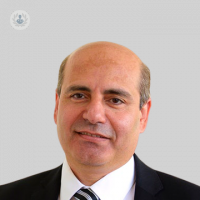What is hemifacial spasm, and what are the causes?
Written by:In one of our latest articles, Mr Allaaeldin Abumattar, a highly respected and skilled Swindon-based consultant ophthalmic surgeon, details what hemifacial spasm is, outlines the causes of the condition, and reveals whether or not hemifacial spasm could be a sign of a more serious underlying condition.

What is hemifacial spasm?
Hemifacial spasm (HFS) presents in the fifth or sixth decade of life as recurrent, intermittent, painless, and unintentional contraction of the muscles on one half of the face innervated by the facial nerve. It almost always affects one side of the face, although both sides may be affected in severe cases.
What are the causes of hemifacial spasm?
Hemifacial spasm (HFS) is commonly caused by compression of the nerve (facial nerve) by a blood vessel. When the blood vessel touches or pulsates against the nerve, it damages the outer surface (the insulation) of it. This causes unplanned and unwanted messages to be transmitted along the nerve.
These messages provoke unintentional contractions of the muscles, which leads to HFS. It may also be caused by a facial nerve injury or a tumour. Sometimes, though, there is no known cause.
Could hemifacial spasm be a sign of something more serious?
Yes, it can indeed. Less than one per cent of HFS cases are caused by a tumour. Pinpointing the exact cause is not always straightforward. Several tests are available to help determine the cause of the spasms, such as MRI scans to make pictures of structures inside the head and rule out tumours and aneurysms.
Studies have shown that the most effective method of hemifacial spasm screening is MRI scans and EMG scans to accurately measure the electrical activity of the muscles.
What are the possible treatments for hemifacial spasm?
The treatment of choice is an injection of botulinum toxin under electromyographic (EMG) guidance. Botulinum safely and effectively treats most patients, especially those with sustained contractions. Relief of spasms occurs between three to five days after injection and lasts approximately six months.
Medications used in the treatment of hemifacial spasm include carbamazepine and benzodiazepines for non-compressive lesions. Carbamazepine, benzodiazepines, and baclofen also may be used in patients who refuse botulinum toxin injections.
Compressive lesions need to be treated surgically. Microvascular decompression surgery may be effective for those patients who do not respond to botulinum toxin.
Is hemifacial spasm genetic?
No. Hemifacial spasms typically begin in the fifth or sixth decade of life. An onset of hemifacial spasms in patients younger than 40 years of age is unusual and often heralds an underlying neurologic illness (eg, multiple sclerosis).
Can hemifacial spasm worsen if left untreated?
Yes. It affects one side of the face and may start by only affecting the muscles around the eye which overtime may progress to involve the entire half of the face or even spread to other parts of the same side of the face and body, including the eyebrow, cheek, the area around the mouth such as lips, chin, jaw, as well as the upper neck.
Mr Allaaeldin Abumattar is an exceptionally distinguished consultant ophthalmic surgeon who can help you if you have recently been or are currently experiencing hemifacial spasm. Book an appointment with him today via his Top Doctors profile.


